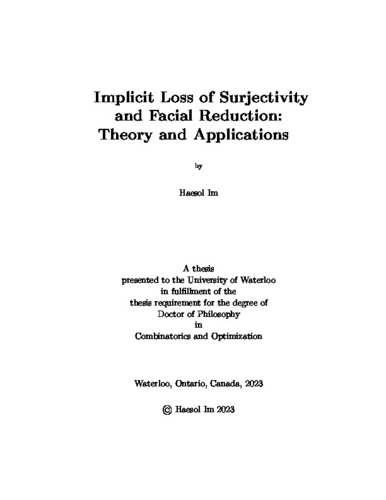UWSpace will be migrating to a new version of its software from July 29th to August 1st. UWSpace will be offline for all UW community members during this time.
Implicit Loss of Surjectivity and Facial Reduction: Theory and Applications
| dc.contributor.author | Im, Haesol | |
| dc.date.accessioned | 2023-03-09 18:56:55 (GMT) | |
| dc.date.available | 2023-03-09 18:56:55 (GMT) | |
| dc.date.issued | 2023-03-09 | |
| dc.date.submitted | 2023-03-07 | |
| dc.identifier.uri | http://hdl.handle.net/10012/19194 | |
| dc.description.abstract | Facial reduction, pioneered by Borwein and Wolkowicz, is a preprocessing method that is commonly used to obtain strict feasibility in the reformulated, reduced constraint system. The importance of strict feasibility is often addressed in the context of the convergence results for interior point methods. Beyond the theoretical properties that the facial reduction conveys, we show that facial reduction, not only limited to interior point methods, leads to strong numerical performances in different classes of algorithms. In this thesis we study various consequences and the broad applicability of facial reduction. The thesis is organized in two parts. In the first part, we show the instabilities accompanied by the absence of strict feasibility through the lens of facially reduced systems. In particular, we exploit the implicit redundancies, revealed by each nontrivial facial reduction step, resulting in the implicit loss of surjectivity. This leads to the two-step facial reduction and two novel related notions of singularity. For the area of semidefinite programming, we use these singularities to strengthen a known bound on the solution rank, the Barvinok-Pataki bound. For the area of linear programming, we reveal degeneracies caused by the implicit redundancies. Furthermore, we propose a preprocessing tool that uses the simplex method. In the second part of this thesis, we continue with the semidefinite programs that do not have strictly feasible points. We focus on the doubly-nonnegative relaxation of the binary quadratic program and a semidefinite program with a nonlinear objective function. We closely work with two classes of algorithms, the splitting method and the Gauss-Newton interior point method. We elaborate on the advantages in building models from facial reduction. Moreover, we develop algorithms for real-world problems including the quadratic assignment problem, the protein side-chain positioning problem, and the key rate computation for quantum key distribution. Facial reduction continues to play an important role for providing robust reformulated models in both the theoretical and the practical aspects, resulting in successful numerical performances. | en |
| dc.language.iso | en | en |
| dc.publisher | University of Waterloo | en |
| dc.subject | strict feasibility | en |
| dc.subject | facial reduction | en |
| dc.subject | stability | en |
| dc.subject | linear programming | en |
| dc.subject | semidefinite programming | en |
| dc.subject | implicit redundancy | en |
| dc.title | Implicit Loss of Surjectivity and Facial Reduction: Theory and Applications | en |
| dc.type | Doctoral Thesis | en |
| dc.pending | false | |
| uws-etd.degree.department | Combinatorics and Optimization | en |
| uws-etd.degree.discipline | Combinatorics and Optimization | en |
| uws-etd.degree.grantor | University of Waterloo | en |
| uws-etd.degree | Doctor of Philosophy | en |
| uws-etd.embargo.terms | 0 | en |
| uws.contributor.advisor | Wolkowicz, Henry | |
| uws.contributor.affiliation1 | Faculty of Mathematics | en |
| uws.published.city | Waterloo | en |
| uws.published.country | Canada | en |
| uws.published.province | Ontario | en |
| uws.typeOfResource | Text | en |
| uws.peerReviewStatus | Unreviewed | en |
| uws.scholarLevel | Graduate | en |

